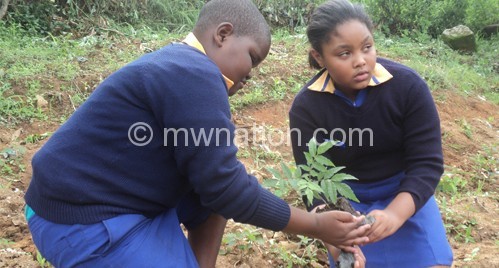Where are the planted trees?

Research shows 60 percent of planted trees do not survive. Why is this the case and what can be done to reverse the situation?
There was an environmental reason that moved brothers John and Fredrick Moir to construct the first tall building in 1832 at Mandala in Kabula—a two-storey building that heralded the birth of Blantyre City.
Kabula was well guarded by a chain of Mpingwe, Michiru, Ndirande and Soche mountains that were green with natural trees.
In fact, when Kabula changed its name to Blantyre and began to grow in the 1960s into a commercial city it is today, the green of the four mountains spiced its splendour.
That splendour, today, is gone. Apart from Michiru Mountain, the other three mountains have lost the green that defined Blantyre’s natural beauty. They all stand bare.
In an attempt to reverse the lost beauty, there have been efforts by various groups to reforest these mountains. For instance, since 1999, Ndirande Mountain has been a beneficiary of a number reforestation efforts by various individuals and organisations.
But if you gaze at Ndirande Mountain, today, it is still as bald-headed as it used to be. The question everybody is asking is: What happened to the trees that were planted in the mountain?
Unfortunately, concerns about continued baldness of Ndirande Mountain against tenacious waves of reforestation do not end in Blantyre.
Since Malawi started the National Tree Campaign in 1980s, an average of 55 million trees are planted every year. This exercise is part of government’s efforts to reforest the country, and it has invested hundreds of millions of kwacha to the exercise.
In fact, according to Nyuma Mughogho, deputy director of forestry in the department of forestry, Malawi needs to plant about 125 million trees each year at a survival rate of 100 percent if trees that have been cut are to be replaced.
However, it is one thing to plant a tree; and yet another for that tree to survive into maturity. Despite huge resources invested, there appears to be a consensus that very few trees planted survive.
Speaking during the launch of the 2013/14 National Forestry Season, Vice-President Khumbo Kachali expressed concern that most trees Malawians planted do not survive.
Communications and advocacy officer in the Department of Forestry Charles Gondwe also confirmed that his department is aware that some planted trees do not survive.
The Coordination Union for Rehabilitation of the Environment (Cure), in a position paper titled Status of Forests and Tree Management in Malawi, argues that every year, Malawi is planting trees.
“A lot of financial resources are being used for launching the national forestry season, followed by regional and district launching functions. These ceremonial functions use a lot of financial resources compared to the output (the actual trees planted). Furthermore, very few of the trees that are planted survive,” it reads.
With the survival rate of planted trees pegged at 40 percent by researchers, Gondwe says some of the factors contributing to the low survival rate of planted trees include late planting of tree seedlings; inadequate management or care for planted trees, animal browsing and uncontrolled fires.
However, in a quest to reverse the problem, the department of forestry has been changing the period for tree planting from the initial one-day event to the current four-month period.
“The reason for extending the period has been simply to encourage people to take care of the planted trees. People are encouraged to plant trees with the first rains, as they plant their food crops.
“After planting, the four-month period is for the farmers to monitor growth and undertake all the necessary weeding practices. Farmers should not plant trees and leave them to grow without managing the weeds and animal browsing,” says Gondwe.
Mughogho, on the other hand, says the department has intensified tree caring in order to improve the survival rate.
“We have extension workers all over the country. These workers are advising tree planters to weed their trees to protect them from fires and animals,” she says.
She adds that government and other organisations have sometimes given incentives for tree planting and management. For instance, the Local Development Fund (LDF) implements forestry programmes under cash-for-work programmes.
On their part, Cure says there is need for government and its partners to put in place a tree planting and management strategy which will monitor the planted trees until they are fully grown.





